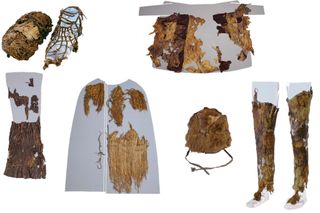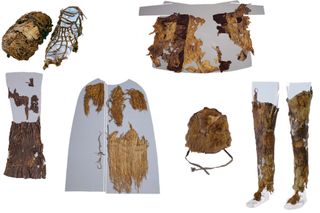
Ötzi the Iceman's hard-core leather outfit would have made animal rights activists shudder.
The 5,300-year-old iceman mummy, whose remarkably preserved body was found frozen in the Tyrolean Alps in Austria, once sported an outfit made almost completely of animal skin, new genetic evidence suggests. And scientists even know which animals were used to make this Stone Age getup.
"We have discovered that the iceman's clothes were composed of an array of different animals," said study co-author Niall O'Sullivan, a doctoral candidate in archaeology at the University College Dublin in Ireland and researcher at the Institute for Mummies and the Iceman, EURAC research in Bolzano, Italy.
The new findings reveal even more about one of the best-studied mummies on Earth. [Top 9 Secrets About Ötzi the Iceman]
Most famous of mummies
Ötzi the Iceman was first discovered by hikers in the Ötztal Alps, along the border with Austria and Italy, in 1991. Since then, the astonishingly well preserved body has been scrutinized down to the tiniest detail, from his clothing, to his day job, to his last meal, to his likely cause of death and poor oral hygiene. A genetic analysis in 2013 even found some of the iceman's living relatives.
A 2008 study determined that some of the hair from Ötzi's animal-skin clothing came from domesticated animals. Yet despite decades' worth of extensive analysis of minute details, researchers had yet to determine exactly which animals contributed their skin to Ötzi's fashion sense.
To answer that question, O'Sullivan and his colleagues attempted to gather genetic data from Ötzi's outfit. This could be a tricky task, as the leather might have been treated by scraping, intense heating and exposure to fatty acids, the researchers wrote in the study, which was published today (Aug. 18) in the journal Scientific Reports. Later, researchers handling the garments might have contaminated the material, while the freeze-drying used to preserve it could have further damaged the genetic material, the researchers said.
Sign up for the Live Science daily newsletter now
Get the world’s most fascinating discoveries delivered straight to your inbox.
Menagerie of animals
By using more modern, next-generation sequencing techniques that amplify certain target strands of DNA, the team was able to identify the species associated with each piece of clothing.
Ötzi's leather overcoat was made of a grab bag of at least four different individual animals from two species — sheep and goat — while his lighter coat was made of sheep. His leggings were made of goatskin, perhaps because that type of animal skin provided the suppleness needed for walking, the researchers hypothesized in the paper. To top off the wardrobe, his leather shoes were stuffed with grass, and he sported shoelaces derived from wild cow, or auroch, the researchers found.
This outfit would have been quite toasty in the chilly Alpine region, as most of the clothing would have been stuffed with grass or other filling to add extra warmth, O'Sullivan said.
His furry hat was once part of a brown bear, while his quiver was made from a roe deer. Those findings suggest that Ötzi had access to trapped or hunted game.

"It is probable that the Iceman was not a hermit. He likely traded furs or domestic animals," O'Sullivan told Live Science in an email.
However, without any written history, there's no definitive way to know whether Ötzi trapped those animals himself or traded for them — or whether Ötzi himself was a skilled tailor or he procured the finished clothing somehow, O'Sullivan added.
Original article on Live Science.

Tia is the managing editor and was previously a senior writer for Live Science. Her work has appeared in Scientific American, Wired.com and other outlets. She holds a master's degree in bioengineering from the University of Washington, a graduate certificate in science writing from UC Santa Cruz and a bachelor's degree in mechanical engineering from the University of Texas at Austin. Tia was part of a team at the Milwaukee Journal Sentinel that published the Empty Cradles series on preterm births, which won multiple awards, including the 2012 Casey Medal for Meritorious Journalism.
